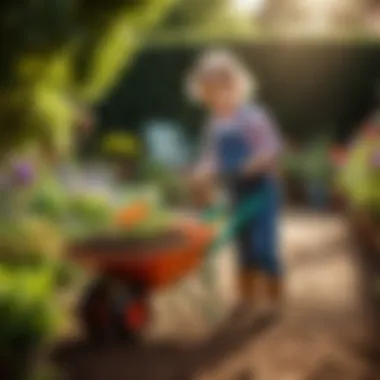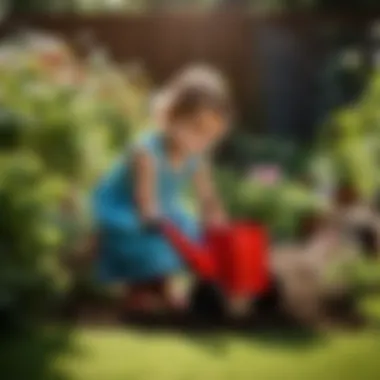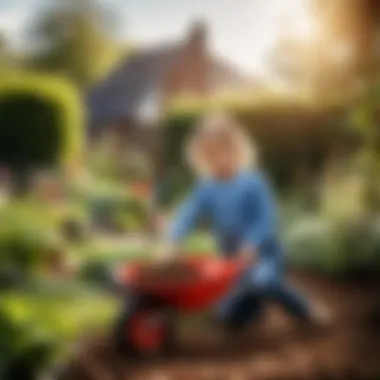Materials:
- Child's wheelbarrow sized appropriately for the child's age and height. Ensure it is sturdy and durable, made of high-quality materials for longevity.
- Child-sized garden tools such as a trowel, rake, shovel, and gardening gloves. Opt for lightweight yet durable options tailored for small hands.
- Potting soil or compost rich in nutrients to support plant growth. Select a high-quality blend suitable for the specific plants your child will be cultivating.
- Seeds or seedlings of various plants like flowers, herbs, or vegetables. Choose a mix of easy-to-grow varieties to maintain your child's interest and excitement.
- Watering can or hose with a gentle spray nozzle for watering the plants. Ensure it's easy for the child to handle and maneuver.
DIY Steps:
- Choose a suitable outdoor location for the child's gardening area, ensuring access to sunlight and water sources. Clear the area of any debris or obstacles to create a safe and conducive space.
- Teach your child how to use each garden tool correctly, emphasizing safety precautions and proper handling techniques. Encourage them to explore and familiarize themselves with the tools.
- Fill the wheelbarrow with the potting soil or compost, allowing the child to participate in the filling process. Explain the importance of soil quality for plant growth.
- Select seeds or seedlings and guide your child in planting them in the wheelbarrow, spacing them appropriately and gently patting the soil around them. Encourage them to ask questions and learn about each plant variety.
- Demonstrate how to water the plants effectively, ensuring they receive adequate moisture without overwatering. Involve your child in the watering routine to instill a sense of responsibility.
Technical Aspects:
- Timing specifics: Engage in gardening activities during optimal periods of the day to maximize plant growth, typically in the morning or early evening.
- Critical techniques: Teach your child the importance of proper watering, sunlight exposure, and weeding to maintain healthy plants. Introduce basic gardening concepts such as germination and photosynthesis.
DIY Project Process:


- Incorporate regular gardening sessions into your child's routine, allowing them to observe the growth progress of their plants. Encourage them to document their findings and experiences.
- Implement a reward system for milestones achieved in the gardening process, such as blooming flowers or harvested vegetables. Celebrate their efforts and nurture their enthusiasm.
- Troubleshooting Tips: If plants show signs of distress or poor growth, educate your child on common issues like overwatering or nutrient deficiencies. Collaborate to find solutions and adjust care practices accordingly.
Introduction


Child's wheelbarrow and garden tools play a crucial role in a child's development, providing a hands-on approach to learning and fostering a connection with nature. This section explores the various aspects and benefits of integrating these tools into a child's activities, highlighting their significance in promoting creativity, responsibility, physical activity, and outdoor engagement.
Understanding Child's Wheelbarrow and Garden Tools
Brief History of Child's Wheelbarrow and Garden Tools
Child's wheelbarrows and garden tools have a rich history dating back to early civilizations, where miniature versions were used to teach children essential gardening skills and household chores. The evolution of these tools has transformed them into essential elements of children's play, allowing kids to mimic adult tasks in a safe and educational manner. The introduction of child-friendly designs and materials has made these tools both safe and appealing to young learners. Despite some limitations in size and durability compared to adult equivalents, child-sized wheelbarrows and garden tools offer a perfect balance of functionality and safety for young users.
Types of Tools Available for Children
Children's garden tools range from shovels and rakes to watering cans and mini wheelbarrows, each serving a specific purpose in cultivating a child's interest in gardening and outdoor activities. These tools are designed with bright colors, lightweight materials, and ergonomic handles to ensure ease of use and safety for young users. While each tool has its unique features and benefits, they collectively contribute to engaging children in gardening, instilling a sense of responsibility, and nurturing a love for nature. Despite potential limitations in durability, child-sized tools provide an ideal introduction to the world of gardening and outdoor play.
Importance of Outdoor Play for Children
Promoting Physical Fitness
Outdoor play promotes physical fitness in children by encouraging movement, exercise, and exploration in natural environments. Children engaging in outdoor activities such as gardening, using wheelbarrows, and digging in the soil develop gross motor skills, strength, and coordination. The physical exertion involved in outdoor play helps children stay active and maintain a healthy lifestyle, fostering habits that promote overall well-being. Despite the risk of minor cuts or scrapes, these activities offer numerous benefits for children's physical development.
Enhancing Cognitive Development
Outdoor play enhances cognitive development by stimulating a child's problem-solving skills, creativity, and imagination. Engaging in gardening activities with tools like wheelbarrows encourages children to think critically, plan, and execute tasks independently. The sensory experiences gained from outdoor play contribute to cognitive development, sensory integration, and spatial awareness. Despite minor challenges such as dirt or mud, outdoor activities offer valuable opportunities for children to explore, learn, and develop cognitive skills in a hands-on and experiential manner.
Benefits of Child's Wheelbarrow and Garden Tools


Physical Benefits
Improving Gross Motor Skills
Improving gross motor skills through the use of child's wheelbarrow and garden tools is a foundational aspect of their development. This includes activities such as pushing the wheelbarrow, shoveling soil, and lifting tools, which all contribute to enhancing coordination, strength, and control in children. By engaging in these physical tasks, children not only improve their motor skills but also develop a sense of accomplishment and self-efficacy. The unique feature of improving gross motor skills lies in its ability to engage children in physical activity while fostering a sense of independence and achievement. This aspect of physical development is essential in promoting overall health and well-being in children.
Enhancing Hand-Eye Coordination
Enhancing hand-eye coordination is another critical benefit that child's wheelbarrow and garden tools offer. By maneuvering tools, planting seeds, and tending to plants, children refine their dexterity and coordination skills. The key characteristic of this skill enhancement is its direct correlation to improved cognitive function and spatial awareness. Through activities that require precise hand movements and visual acuity, children not only enhance their motor skills but also develop a keen sense of observation and precision. The advantage of this aspect in the use of garden tools is its holistic approach to development, seamlessly merging physical and cognitive abilities for comprehensive growth.
Cognitive Benefits
Encouraging Problem-Solving Skills
Encouraging problem-solving skills through gardening activities empowers children to think critically and analytically. Tackling challenges such as soil preparation, plant care, and garden maintenance requires logical reasoning and creative problem-solving approaches. The key characteristic of this cognitive benefit lies in its ability to nurture a child's ability to overcome obstacles and find innovative solutions independently. By engaging in tasks that involve planning, executing, and evaluating outcomes, children develop resilience, adaptability, and resourcefulness. The advantage of fostering problem-solving skills in gardening activities is the practical application of theoretical knowledge, bridging the gap between academic learning and real-world experiences.
Fostering Creativity and Imagination
Fostering creativity and imagination in children through garden tools opens a realm of possibilities for self-expression and exploration. The hands-on experience of planting, designing, and caring for a garden ignites a child's innate creativity and encourages imaginative thinking. The key characteristic of this cognitive benefit is its potential to inspire children to create, innovate, and communicate through natural elements. By engaging in tasks that require artistic vision, experimentation, and innovation, children not only express themselves creatively but also develop a profound connection to the beauty and wonder of the natural world. The advantage of fostering creativity and imagination in garden activities is its capacity to nurture a child's holistic development, encompassing emotional, cognitive, and sensory domains.
Emotional Benefits
Building Self-Confidence
Building self-confidence through the use of garden tools empowers children to take ownership of their actions and decisions. Accomplishing tasks such as planting seeds, harvesting vegetables, and maintaining a garden instills a sense of pride and self-assurance in children. The key characteristic of building self-confidence lies in its ability to boost self-esteem, resilience, and sense of competence. By engaging in activities that foster independence and accountability, children develop a positive self-image and a growth mindset. The advantage of building self-confidence in gardening activities is the lasting impact it has on a child's emotional well-being, shaping their perception of themselves as capable, resourceful individuals.
Teaching Responsibility
Teaching responsibility through garden tools cultivates a sense of duty, respect, and stewardship in children. Caring for plants, tending to the garden, and maintaining tools instills a strong sense of responsibility and accountability. The key characteristic of teaching responsibility is its role in shaping ethical values, interpersonal skills, and environmental awareness. By engaging in tasks that require commitment, organization, and diligence, children learn the importance of caring for living things and respecting their surroundings. The advantage of teaching responsibility through gardening activities is the profound impact it has on a child's moral development, fostering empathy, integrity, and a sense of interconnectedness with the natural world.
Safety Precautions and Guidelines
Safety precautions and guidelines play a crucial role in ensuring the well-being of children engaging with wheelbarrows and garden tools. In this article, we delve into specific elements, benefits, and considerations regarding the safety of children.
Ensuring Safe Usage of Child's Wheelbarrow and Garden Tools
Supervision and Guidance
Supervision and guidance are paramount when it comes to children's interactions with wheelbarrows and garden tools. Responsible adults must oversee and direct children during these activities to prevent accidents or misuse. The key characteristic of supervision and guidance lies in providing a safe environment for children to explore and learn essential skills. Its unique feature is the ability to offer immediate assistance and instruction, aiding in the development of proper tool usage. Supervision and guidance significantly reduce the risk of injuries, making it a popular and beneficial choice for enhancing child safety in this context.
Proper Tool Maintenance
Maintaining tools in good condition is vital for the safety of children using wheelbarrows and garden equipment. Proper tool maintenance involves regularly checking for any defects, sharpening blades when necessary, and storing tools in a secure location. The key characteristic of proper tool maintenance is preserving the longevity and effectiveness of the tools, ensuring safe usage for children. Its unique feature lies in promoting responsible tool ownership among children as they learn the importance of upkeep. While requiring diligence, proper tool maintenance offers the advantage of prolonging tool lifespan and reducing the risk of accidents, making it a valuable practice within this article.
Teaching Children About Safety
Usage of Safety Gear
Instructing children to use safety gear such as gloves, goggles, and aprons is essential for their protection while engaging in gardening activities. The key characteristic of safety gear is providing a physical barrier between children and potential hazards, reducing the likelihood of injuries. A unique feature of safety gear is instilling a sense of responsibility in children towards their safety, promoting independent decision-making and self-care. While adding an extra layer of safety, safety gear also encourages children to take precautionary measures seriously, enhancing their awareness of potential risks. Emphasizing the usage of safety gear not only safeguards children but also educates them on the importance of personal protective equipment in a hands-on environment.
Handling Sharp Tools
Teaching children how to handle sharp tools safely is paramount in preventing accidents during gardening tasks. The key characteristic of handling sharp tools is emphasizing the proper grip, angle, and movements required to use these tools effectively. Understanding the unique features of sharp tools and their potential risks is essential for children to develop respect and caution when handling them. While sharp tools require careful supervision and instruction, they offer the advantage of teaching children precision and finesse while working in the garden. By highlighting the importance of handling sharp tools correctly, children can elevate their skill level and safety awareness, making this aspect of safety education indispensable in garden tool usage.
Educational Opportunities
Learning Through Play
Planting and Harvesting:
Delving into the intricacies of planting and harvesting exposes children to the fundamental aspects of agriculture and plant life cycles. This specific component encourages children to get their hands dirty, understand the growth process of plants, and appreciate the effort that goes into producing food. Planting and harvesting not only instill a sense of responsibility but also promote a connection to nature that is vital for their holistic development. The ability to witness the transformation of a seed into a fully grown plant fosters patience, nurturing skills, and an understanding of the natural world.
Understanding Ecosystems:
Exploring ecosystems introduces children to the interconnected relationships between living organisms and their environment. By grasping the concept of ecosystems, children develop a profound appreciation for the delicate balance that sustains life on Earth. They learn about the importance of biodiversity, the effects of human activity on ecosystems, and how every living organism plays a role in maintaining ecological harmony. Understanding ecosystems not only nurtures a sense of environmental stewardship but also cultivates a broader perspective on conservation and sustainability.
Incorporating STEM Learning
Exploring Science and Math Concepts:
Engaging in science and math through gardening activities offers children a practical way to apply theoretical concepts in a real-world setting. By exploring scientific principles such as photosynthesis, plant growth, and mathematical concepts like measurements and proportions, children develop a holistic understanding of STEM disciplines. This hands-on approach to learning fosters critical thinking, problem-solving skills, and a curiosity for exploring the natural world through a scientific lens.
Engaging in Hands-On Experiments:
The integration of hands-on experiments in gardening activities enables children to conduct empirical investigations, form hypotheses, and draw conclusions based on observation and data collection. Through experiments such as testing soil pH levels, studying the impact of light on plant growth, or analyzing the effects of different nutrients on plants, children enhance their analytical skills and scientific literacy. Engaging in hands-on experiments not only sparks curiosity and innovation but also nurtures a culture of experimentation and discovery among young minds.
Parental Involvement and Support
In the realm of gardening and outdoor activities, parental involvement and support play a crucial role in shaping a child's experiences and fostering a love for nature. By actively engaging in their child's exploration of the garden and encouraging hands-on activities, parents can instill valuable lessons in responsibility, teamwork, and appreciation for the environment. Maintaining open communication channels with children about the importance of nature, plants, and sustainability can lead to a deeper connection and understanding of the world around them. Parents who actively participate in gardening activities alongside their children not only create lasting memories but also cultivate a sense of community and shared accomplishment within the family unit.
Encouraging Outdoor Exploration
Creating a Child-Friendly Garden Space
Creating a child-friendly garden space involves designing an area that is inviting, safe, and engaging for young ones to explore. Incorporating elements such as colorful plants, tactile sensory pathways, and child-sized garden tools can stimulate a child's curiosity and encourage active participation in caring for the space. The use of durable, child-friendly materials and non-toxic plants ensures a secure environment for children to learn and play freely. This approach fosters a sense of ownership and responsibility in children, nurturing their appreciation for nature and the environment.
Participating in Gardening Activities
Participating in gardening activities offers children a hands-on opportunity to learn about plant life cycles, healthy eating habits, and the importance of sustainability. By involving children in planting, watering, weeding, and harvesting, parents can teach valuable skills such as patience, nurturing, and diligence. Gardening fosters a sense of accomplishment as children witness the fruits of their labor blooming and growing. Moreover, working together in the garden provides a platform for communication, bonding, and shared experiences that strengthen familial relationships while nurturing a deeper appreciation for the natural world.
Communication and Bonding
Sharing Gardening Tips and Tricks
Sharing gardening tips and tricks with children opens up avenues for learning, problem-solving, and creativity. Explaining the importance of sunlight, soil composition, and watering techniques imparts valuable knowledge while fostering a sense of curiosity and inquiry in young minds. Encouraging children to ask questions, make observations, and experiment with different gardening methods can enhance their problem-solving skills and critical thinking abilities. Moreover, sharing this knowledge provides opportunities for bonding, shared interests, and mutual learning experiences that strengthen the parent-child relationship.
Supporting Creative Endeavors
Supporting children's creative endeavors in the garden enables them to express themselves, experiment with different artistic mediums, and explore their imagination. Allowing children the freedom to design their garden plots, create DIY plant markers, or paint rocks for decoration nurtures their sense of individuality and self-expression. Engaging in creative activities together fosters a sense of collaboration, experimentation, and innovation, while providing children with a platform to showcase their unique talents and interests. By supporting and encouraging creativity in the garden, parents empower children to think outside the box, embrace new ideas, and develop their artistic skills in a natural and nurturing environment.





